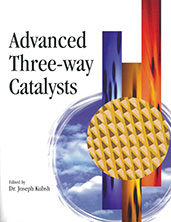Journal Article
Investigation of LEV-III Aftertreatment Designs
2011-04-12
2011-01-0301
Proposed LEV-III emission level will require improvements in NMOG, CO and NOx emissions as measured over FTP and US06 emission cycles. Incremental improvements in washcoat technologies, cold start calibration and catalyst system design are required to develop a cost effective solution set. New catalyst technologies demonstrated both lower HC and NOx emissions with 25% less platinum group metals (PGM). FTP and US06 emissions were measured on a 4-cylinder 2.4L application which compares a close-coupled converter and close-coupled + underfloor converter systems. A PGM placement study was performed with the close-coupled converter system employing these new catalyst technologies. Emissions results suggest that the placement of PGM is critical in minimizing emissions and PGM costs.

